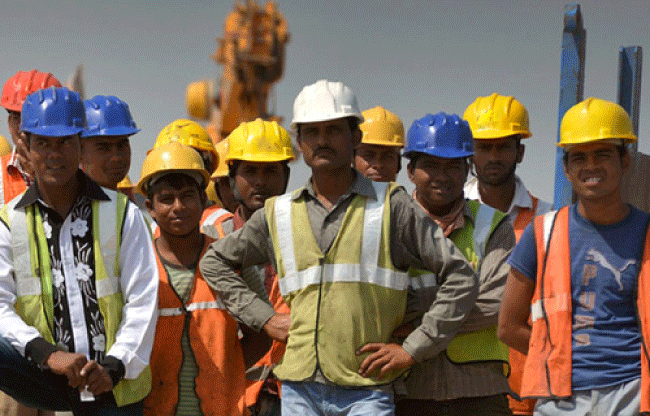This article is written by Abhishek Chaudhary Attri, from UPES, School of Law, Dehradun. The author has critically analyzed the new labour codes and how the Covid-19 has brought changes in the working conditions under the new laws.
Table of Contents
Introduction
The Covid crisis unfolded the unthinkable before our eyes, it led to a forceful shutdown of businesses and industries across the country. The worst affected were the migrant workers; their employers refused to pay them citing the losses they incurred and their landlords continuously forcing them to pay rent. They still had to bear the cost of all their necessities such as water, electricity and food. All of this with a bare minimum wage and little or no savings made them flee from the cities they once worked in, to their native lands. The situation now has improved and things have started to get back on track, towards a “new normal”.
As labour is a subject mentioned in the concurrent list under the Seventh Schedule of the Indian Constitution, the government soon recognised the need for the changes in the labour codes to adapt to the “new normal” and prepare itself for such future contingencies and hence merged 29 central labour laws to form 3 new labour codes.
The new labour codes 2020: friend or foe for the workers in India
Industrial Relations Code, 2020
The Industrial Relations Code, 2020 came into force by codifying the Industrial Disputes Act, 1947, The Trade Unions Act, 1926, and The Industrial Employment (Standing Orders) Act, 1946. Several changes have been made in the definitions.
Worker
The definition of the workers has been expanded to include working journalists and other newspaper employees. Also, the persons employed with a supervisory capacity and earning less than Rs. 18,000 per month have been included.
Industry
The term industry now excludes the institutions owned or managed by organizations that are wholly or substantially involved in any charitable or philanthropic services. Any activity of the appropriate government which is relatable to the sovereign functions of the appropriate Government includes all the activities carried on by the departments dealing with defence research, atomic energy and space. Any domestic services or any other activity may be notified by the Central Government.
Employer
An employer has been defined in Section 2(m) of the IR Code. It takes into account the definition provided in Section 2(n) and Section 7(1)(f) of the Factories Act, 1948.
Fixed-term employment
This refers to the working of an employee based on a written contract of employment of a fixed period, where such employee will be granted equal working hours, wages, allowances, statutory benefits and other benefits as much as a permanent employee.
Standing orders
Standing orders are provided under Chapter IV of the Code. These orders are the rules made by the employer for the workforce employed in the industrial establishments, which formally define the condition of employment and apply to establishments with 300 workers being employed on any working day. The employer shall prepare the standing orders on the following matters listed in the First Schedule of the IR Code.
- Classification of workers as to whether the workers are temporary, permanent, apprentices or fixed-term employees.
- The manner in which the workers shall be intimated the periods and hours of work, holidays, paydays and wages rates.
- Shift working.
- Attendance and late coming.
- Conditions and procedure in regards to providing grant leave and holiday.
- Liability to search while entering certain areas in the premises.
- Rights and liability arising from the closing and reporting of sections of the industrial establishment.
- Notice by the employer and workers for the termination of employment.
- Acts or omissions that lead to misconduct and the subsequent suspension or dismissal.
- Any matter specified by the appropriate Government by notification.
The model standing orders shall be made by the government and when an employer adopts the model standing order with matters concerned with the establishment or undertaking then such orders shall be deemed to be certified. The previous stated that the grievance settlement committee was to be set up in an establishment with more than 50 workers and no equal representation of women was mentioned.
Constitution of Industrial Tribunals
- This would come in place of the multiple adjudicating bodies under the Industrial Disputes Act such as the court of inquiry, board of conciliation and labour codes.
- The new IR Code will set up a National Industrial Tribunal to decide the industrial disputes also by the notice of the central government more such can be constituted.
- Every tribunal shall consist of two members which are appointed by the appropriate government and one shall be a judicial member and the other shall be an administrative member.
Prohibition on strikes and lock-outs
- As per Section 62, no worker can go on a strike without sixty days of prior notice to the employer, or within fourteen days of giving such notice, or when the conciliation proceedings are pending or seven after their conclusion or sixty days after the conclusion of arbitral proceedings.
- No employer shall lock out the workers unless the above-mentioned conditions are met.
Lay-off, retrenchment and closure
- In case an industrial establishment with more than a hundred workers, closes, lay-off or retrench the workers, it shall take prior permission from the appropriate government as per the previous Industrial Disputes Act.
- The IR Code had waived off the industrial establishments such as mines, factories and plantations from such requirements given that the establishment shall contain no less than 300 workers.
- Such prior permission is not required in cases when the lay-off is due to fire, flood, or leakage of inflammable gas or explosion.
- If the decision on the application sent by the employer, within a period of 60 days, is not communicated by the government, such application is deemed to have been disposed of.
Appointment of a Negotiating Union/Council
Section 14 of the IR Code states the formation of the negotiating union council in the industrial establishment shall be formed under these circumstances.
- Where only one trade union exists, the employer shall recognize it as the sole negotiating union for the workers.
- Where more than one trade union exists and one trade union has 50% or more workers, the employer shall recognize it as the sole negotiating union for the traders.
- Where more than one trade union exists but no one trade union has 50% or more workers, then the employer shall form a negotiating council with no less than 20% of the workers of the establishment.
Worker Re-skilling Fund
- Section 83 of the IR Code has introduced a worker re-skilling fund for the laid-off employees so that they can secure employment again.
- The employer must utilize the fund to credit the amount which is equivalent to 15 days wages last drawn by the worker or such number of days as reported by the government.
The Occupational Safety, Health and Working Conditions Code, 2020
The Occupational Safety, Health and Working Conditions Code 2020 proposes to subsume 633 provisions of 13 major labour laws into one single code with 143 provisions. It applies to factories with having 20 or more workers and the manufacturing process is carried on with the aid of power (electricity) and also applies to factories with 40 or more workers where the manufacturing process is carried out without the aid of power
The Code emphasizes on the workers employed in various sectors like trade, business, manufacturing, factory, motor transport undertaking, building and other construction work, newspaper establishments, audio-video production, plantation, mines and dock-work and service sectors. The Code doesn’t apply to the Central Government, State Government and any ship of war or any nationality but at the same time, it applies to the contract labour employed through a contractor in the offices where central government or state government are principal employers.
The purpose of this Code is to set up the occupational safety boards to advise the Central and state governments on the national and state-level upon the standards, rules and regulations to be framed under this Code.
The Code on Social Security, 2020
The Code on Social Security was passed by both houses and received the President’s assent on September 28, 2020. The Code is enacted to provide social security to employees and workers either in organized or unorganized sectors. There have been several changes in the definition.
Employee
An employee, under the Social Security Code, refers to a person employed on wages either directly or through a contractor to do a skilled, semi-skilled, unskilled, manual, operational, supervisory, managerial, administrative, technical, clerical or any other work, such that the terms of employment are expressed or implied.
Platform work
Any work arrangement outside of the employer-employee relationship where an online platform is used by individuals or organizations to provide services or solve problems or any such activities notified by the government in exchange for which a payment is received. The person engaged in taking the platform work is known as the platform worker.
Gig worker
The person who earns from performing work or participates in a work arrangement activity other than an employer-employee relationship is called a gig worker.
Social security
It means the measures taken by the government to confer protection upon the employees, unorganized workers, gig workers and platform workers, which ensures access to healthcare income security particularly in the cases when the person is of old age, unemployed, sick, invalid, has work injury, maternity or has lost a breadwinner through schemes framed under the Social Security Code, 2020.
Benefits to gig and platform workers
- Although no particular schemes have been put together, the Social Security Code provides space for the Central and State governments to notify schemes for such workers and mandates that the scheme may be funded through the combined contribution of the centre and the state governments.
- The worker shall be of age 16 or any other prescribed age.
- The worker must have submitted the self-declaration information prescribed by the central government.
Employee provident fund (EPF)
- The Social Security Code mandates the provision of EPF under Chapter 3 to come into play in an organization where the number of employees is 20 or more.
- The employer is liable to pay 10% of the wages payable to the employee to the provident fund and the employee is liable to contribute equally as the employer.
- In the case where an employer has failed to make a contribution, it shall be punishable with an imprisonment of one to three years.
- In case, any employee fails to contribute it shall be fined Rs. 1,00,000/- or maximum imprisonment of 2 months and a maximum of 6 months.
Maternity benefits
- It is applicable in every shop or establishment where more than 10 employees are employed or were employed.
- Maternity leave can be granted for a maximum of 26 weeks and a maximum of 8 weeks shall be granted prior to the expected date of delivery.
- Maternity benefit to a woman with two or more surviving children shall be of 12 weeks and a maximum of 6 weeks before the expected delivery date.
- No employer shall knowingly employ a woman within 6 weeks of delivery, miscarriage or medical termination of pregnancy.
- A woman shall be entitled to the maternity benefits only when she has worked for 80 days in the past 12 months immediately before the date of expected delivery, for the same employer.
- If an employer dismisses, discharges, reduces in rank, penalizes, or does not provide a woman with maternity benefits, then such person shall be punishable with imprisonment for a term of a maximum of 6 months or pay a fine of Rs. 50,000 or both.
Working conditions in the industries as per the Labour Codes, 2020
The hazardous industries are included in the schedules where extra precautions as to the standard of safety and health are to be followed for the well being of workers and safe working conditions along with the list of notifiable diseases that can affect them. These shall be informed to the concerned authorities. For the employer, there are benefits as these codes replace the various registrations required under the different laws with one common registration. One licence and one registration will create a consolidated database centrally and improve the ease of doing business.
The codes aim to keep the workplaces free from hazards that can likely cause an injury to the workers. The employers shall mandatorily conduct the free annual health check-up for their employees. The employers shall be held responsible for the disposal of hazardous and toxic waste including e-waste. Every employee shall be issued an employment letter on their appointment in the establishment.
Workers or employees are entitled to receive overtime at the rate of twice the wage. Employees or contractors are responsible to provide welfare facilities to inter-state migrant workers. The codes bars the civil courts to hear matters concerning the codes.
The working condition of women recognized by the Labour Codes, 2020
The women workforce contribute most in the agricultural sector. The other major sector that the women workforce contributes to is construction. Usually, they would receive low wages and no health protection. The codes have brought gender equality and have provisions for the health and safety of women.
The industrial establishments shall have a separate washroom, bathing places and locker rooms for male, female and transgender employees. The codes have relaxed the working hours and now women can take up all kinds of work before 6:00 AM and beyond 7:00 PM if they provide consent.
In the industries where the working environment is potentially hazardous, the government shall direct employers to provide the women workers with safeguards. However, no guidelines as to safeguards have been notified yet. Restriction on working in hazardous conditions for women which were imposed in the Factories Act, 1948 has been lifted. Earlier the restrictions were on certain processes such as cleaning and moving of transmission machinery, working in cotton presses, lifting and carrying weights and many other processes which may cause bodily injury to women.
The establishments under which women are working are bound to provide creche facilities for kids under 6 years of age; this shall apply to establishments with more than 50 persons, not just women. Earlier the requirement was 30 or more women. The establishments can avail common creche facilities which were offered by State Government, Central Government, Municipalities, Private Bodies or NGOs.
Conclusion
The new labour codes have given the employers a great amount of autonomy and this will, in turn, benefit the ease of doing business but to protect the rights of the workers, the government has intervened in various verticals especially while making laws for the workers who belong to a state other than the state they are employed in. Social security to the employees has been emphasised especially in the informal sector as the previous laws provided coverage to the majority of the employees from the formal sector; also the new form of employees such as gig workers, platform workers who were not recognised earlier, are now included. The inclusion of more firms in the definitions and expanding their employee benefits such as employee provident fund, gratuity etc. will encourage these firms to grow big.
LawSikho has created a telegram group for exchanging legal knowledge, referrals and various opportunities. You can click on this link and join:
https://t.me/joinchat/J_0YrBa4IBSHdpuTfQO_sA
Follow us on Instagram and subscribe to our YouTube channel for more amazing legal content.
 Serato DJ Crack 2025Serato DJ PRO Crack
Serato DJ Crack 2025Serato DJ PRO Crack










 Allow notifications
Allow notifications



